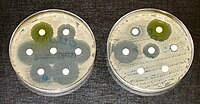
Photo from wikipedia
Abstract Background Tuberculosis (TB) is caused by Mycobacterium tuberculosis and is among the top 10 causes of death worldwide. Multidrug-resistant TB is increasing, with almost 480,000 new cases. According to… Click to show full abstract
Abstract Background Tuberculosis (TB) is caused by Mycobacterium tuberculosis and is among the top 10 causes of death worldwide. Multidrug-resistant TB is increasing, with almost 480,000 new cases. According to drug resistance surveillance data, 3.9% of these are new cases and 21% previously treated TB cases. The aim of this study was to compare the results from the conventional drug susceptibility test (DST) and the sequencing method. Methods The study included 122 individuals with TB. Drug susceptibility was tested by the conventional DST and sequencing. We calculated the drug resistance rate of each anti-tuberculosis agent and compared the resistance pattern according to each method. Results The resistance rates by conventional DST were 6.3, 9.4, 3.1, 7.0, 0.8, and 4.8% for rifampicin, isoniazid, streptomycin, ethambutol, fluoroquinolones, and pyrazinamide, respectively, in the newly diagnosed group, and 4% for both isoniazid and fluoroquinolones in the previously treated group. The resistance rates by sequencing were 6.3, 9.2, 2.0, and 5.8% for rifampicin, isoniazid, ethambutol, and pyrazinamide, respectively, in the newly diagnosed group and 21.1, 28.6, 5.0, and 13.0% for rifampicin, isoniazid, streptomycin, and pyrazinamide, respectively, in the previously treated group. The concordance rates of isoniazid were 70% for resistance and 95% for susceptibility; rifampicin, 80% for resistance and 98% for susceptibility; ethambutol, 98% for susceptibility; pyrazinamide, 17% for resistance and 96% for susceptibility; streptomycin, 98% for susceptibility; and fluoroquinolones, 98% for susceptibility. Conclusion The resistance patterns of rifampicin, isoniazid, and pyrazinamide by both methods were analogous to each other in the newly diagnosed group. In addition, the concordance rates of drug susceptibility were high. Therefore, it is helpful to perform both the conventional DST and sequencing method for more precise detection of drug resistance of M. tuberculosis. Disclosures All authors: No reported disclosures.
Journal Title: Open Forum Infectious Diseases
Year Published: 2018
Link to full text (if available)
Share on Social Media: Sign Up to like & get
recommendations!